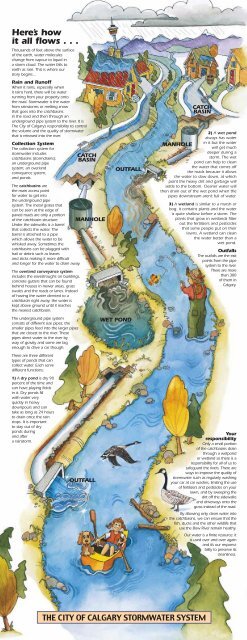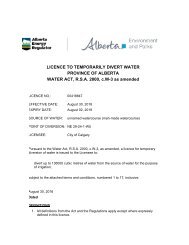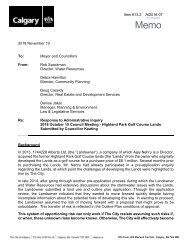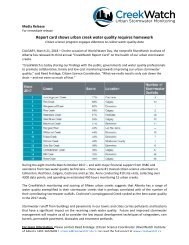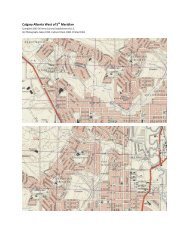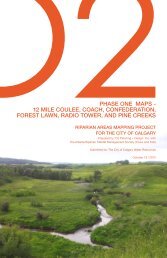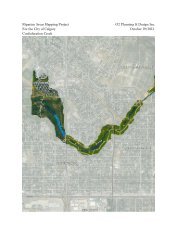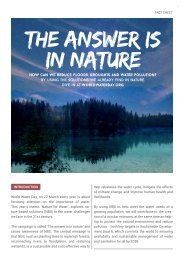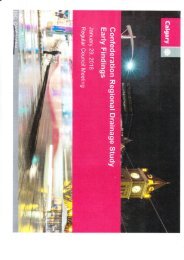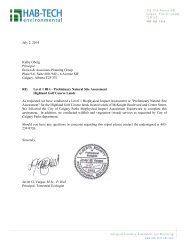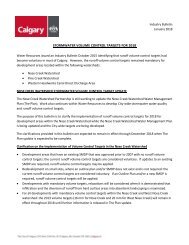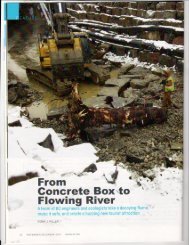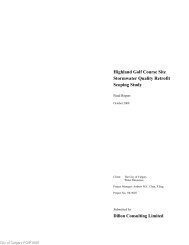storm_sewer_system_brochure
- No tags were found...
You also want an ePaper? Increase the reach of your titles
YUMPU automatically turns print PDFs into web optimized ePapers that Google loves.
Here’s how<br />
it all flows . . .<br />
Thousands of feet above the surface<br />
of the earth, water molecules<br />
change from vapour to liquid in<br />
a <strong>storm</strong> cloud. The water falls to<br />
earth as rain. This is where our<br />
story begins…<br />
Rain and Runoff<br />
When it rains, especially when<br />
it rains hard, there will be water<br />
running from your property onto<br />
the road. Stormwater is the water<br />
from rain<strong>storm</strong>s or melting snow<br />
that goes into the catchbasins<br />
in the road and then through an<br />
underground pipe <strong>system</strong> to the river. It is<br />
The City of Calgary’s responsibility to control<br />
the volume and the quality of <strong>storm</strong>water<br />
that is released into the river.<br />
Collection System<br />
The collection <strong>system</strong> for<br />
<strong>storm</strong>water includes<br />
catchbasins (<strong>storm</strong>drains);<br />
an underground pipe<br />
<strong>system</strong>; an overland<br />
conveyance <strong>system</strong>;<br />
and ponds.<br />
The catchbasins are<br />
the main access point<br />
for water to get into<br />
the underground pipe<br />
<strong>system</strong>. The metal grates that<br />
can be seen at the edge of<br />
paved roads are only a portion<br />
of the catchbasin structure.<br />
Under the sidewalks is a barrel<br />
that collects the water. The<br />
barrel is attached to a pipe<br />
which allows the water to be<br />
whisked away. Sometimes the<br />
catchbasins can be plugged with<br />
hail or debris such as leaves<br />
and sticks making it more difficult<br />
and longer for the water to drain away.<br />
The overland conveyance <strong>system</strong><br />
includes the eavestroughs on buildings,<br />
concrete gutters that can be found<br />
behind houses in newer areas, grass<br />
swales and the roads or lanes. Instead<br />
of having the water directed to a<br />
catchbasin right away, the water is<br />
kept above ground until it reaches<br />
the nearest catchbasin.<br />
The underground pipe <strong>system</strong><br />
consists of different size pipes; the<br />
smaller pipes feed into the larger pipes<br />
that are closest to the river. These<br />
pipes direct water to the river by<br />
way of gravity and some are big<br />
enough to drive a car though.<br />
CATCH<br />
BASIN<br />
MANHOLE<br />
OUTFALL<br />
WET POND<br />
CATCH<br />
BASIN<br />
2) A wet pond<br />
always has water<br />
in it but the water<br />
MANHOLE<br />
will get much<br />
deeper during a<br />
<strong>storm</strong>. The wet<br />
pond can help to clean<br />
the water that comes off<br />
the roads because it allows<br />
the water to slow down, at which<br />
point the heavy dirt and garbage will<br />
settle to the bottom. Cleaner water will<br />
then drain out of the wet pond when the<br />
pipes downstream aren’t full of water.<br />
3) A wetland is similar to a marsh or<br />
bog: it contains plants and the water<br />
is quite shallow before a <strong>storm</strong>. The<br />
plants that grow in wetlands filter<br />
out the fertilizers and pesticides<br />
that some people put on their<br />
lawns. A wetland can clean<br />
the water better than a<br />
wet pond.<br />
Outfalls<br />
The outfalls are the exit<br />
points from the pipe<br />
<strong>system</strong> to the river.<br />
There are more<br />
than 300<br />
of them in<br />
Calgary.<br />
There are three different<br />
types of ponds that can<br />
collect water. Each serve<br />
different functions:<br />
1) A dry pond is dry 90<br />
percent of the time and<br />
can have playing fields<br />
in it. Dry ponds fill<br />
with water very<br />
quickly in heavy<br />
downpours and can<br />
take as long as 24 hours<br />
to drain once the rain<br />
stops. It is important<br />
to stay out of dry<br />
ponds during<br />
and after<br />
a rain<strong>storm</strong>.<br />
OUTFALL<br />
Your<br />
responsibility<br />
Only a small portion<br />
of the catchbasins drain<br />
through a wetpond<br />
or wetland so there is a<br />
responsibility for all of us to<br />
safeguard the rivers. There are<br />
ways to improve the quality of<br />
<strong>storm</strong>water such as regularly washing<br />
your car at car washes, limiting the use<br />
of fertilizers and pesticides on your<br />
lawn, and by sweeping the<br />
dirt off the sidewalks<br />
and driveways onto the<br />
grass instead of the road.<br />
By allowing only clean water into<br />
the catchbasins, we can ensure that the<br />
fish, ducks and the other wildlife that<br />
use the Bow River remain healthy.<br />
Our water is a finite resource: it<br />
is used over and over again<br />
and it’s our responsibility<br />
to preserve its<br />
cleanliness.<br />
THE CITY OF CALGARY STORMWATER SYSTEM


